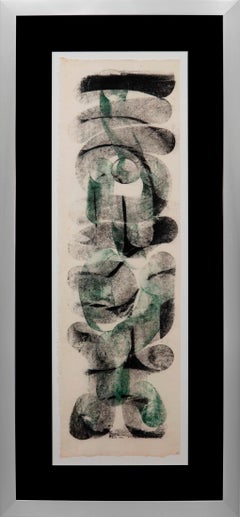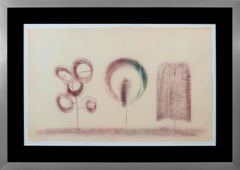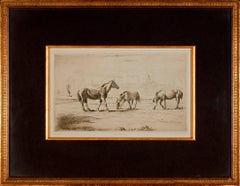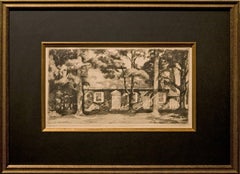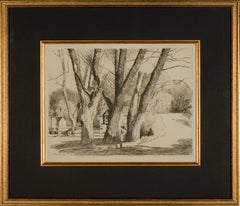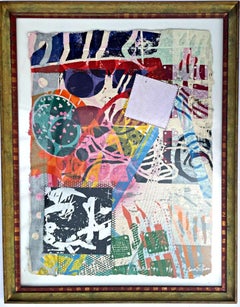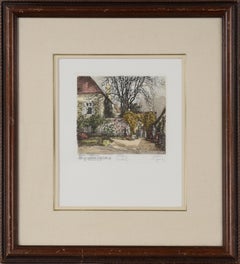Jim's of Lambertville Prints and Multiples
to
6
6
5
1
4
2
Overall Height
to
Overall Width
to
4
2
1
1
1
1
1
1
1
1
6
1
1
1
4
2
4
2
1
"Improvidence"
By Daniel Garber
Located in Lambertville, NJ
Jim’s of Lambertville Fine Art Gallery is proud to present this piece by Daniel Garber (1880 - 1958).
One of the two most important and, so far, the most valuable of the New Hope Sc...
Category
1920s American Impressionist Landscape Prints
Materials
Etching
Vertial Sculpture
By Harry Bertoia
Located in Lambertville, NJ
Jim’s of Lambertville is proud to offer this artwork by:
Harry Bertoia (1915 – 1978)
Artist, sound art sculptor, and furniture designer, Harry Bertoia, was born in Italy in 1915 be...
Category
20th Century Abstract Abstract Prints
Materials
Paper, Monoprint
Three Sound Sculpture
By Harry Bertoia
Located in Lambertville, NJ
Jim’s of Lambertville is proud to offer this artwork by:
Harry Bertoia (1915 – 1978)
Artist, sound art sculptor, and furniture designer, Harry Bertoia, was born in Italy in 1915 before immigrating to America in 1930. In 1936, he attended the Detroit Society of Arts and Crafts before moving to study at Cranbrook Academy of Art in Bloomfield, Michigan, where he would later teach and establish a metalworking department. During this early artistic period, he experimented with jewelry forms, exploring creative concepts that would later emerge in his sculptures.
In 1943, he relocated to Venice, California, along with esteemed artist-designer couple Charles and Ray Eames, to participate in war efforts until 1946. During his first year in California, he began attending a welding class at Santa Monica City College. In 1947, he moved to La Jolla to work in the publications department of Point Loma Naval Electronics Laboratory creating training manuals for equipment operators. During this time, he continued making jewelry and monoprints and began his first experiments with metal sculpture.
In 1949, he moved to Barto, Pennsylvania to work alongside Hans and Florence Knoll at Knoll Associates, a design company and furniture manufacturer. From then on, he became a prolific architectural sculptor. While at Knoll Associates, he created the famous wire Bertoia Collection. Among the designs for this collection was his Diamond Chair, which quickly became an iconic and commercially successful model. His first sculpture exhibition was in 1951 at the Knoll Showroom in New York.
Besides his work in jewelry making and furniture design, during the 1960s, Bertoia began to devote himself to the production of sound sculptures...
Category
20th Century Abstract Abstract Prints
Materials
Monoprint
"Old Barney"
By Daniel Garber
Located in Lambertville, NJ
Jim’s of Lambertville Fine Art Gallery is proud to present this piece by Daniel Garber (1880 - 1958).
One of the two most important and, so far, the most valuable of the New Hope Sc...
Category
Mid-20th Century American Impressionist Landscape Prints
Materials
Etching
"Birmingham Meeting House"
By Daniel Garber
Located in Lambertville, NJ
Jim’s of Lambertville Fine Art Gallery is proud to present this piece by Daniel Garber (1880 - 1958).
One of the two most important and, so far, the most valuable of the New Hope Sc...
Category
1930s American Impressionist Landscape Prints
Materials
Etching
"Spring Valley Willows"
By Daniel Garber
Located in Lambertville, NJ
Jim’s of Lambertville Fine Art Gallery is proud to present this piece by Daniel Garber (1880 - 1958).
One of the two most important and, so far, the most valuable of the New Hope School Painters, Daniel Garber was born on April 11, 1880, in North Manchester, Indiana. At the age of seventeen, he studied at the Art Academy of Cincinnati with Vincent Nowottny. Moving to Philadelphia in 1899, he first attended classes at the "Darby School," near Fort Washington; a summer school run by Academy instructors Anshutz and Breckenridge. Later that year, he enrolled at the Pennsylvania Academy of the Fine Arts. His instructors at the Academy included Thomas Anshutz, William Merritt Chase and Cecilia Beaux. There Garber met fellow artist Mary Franklin while she was posing as a model for the portrait class of Hugh Breckenridge. After a two year courtship, Garber married Mary Franklin on June 21, 1901.
In May 1905, Garber was awarded the William Emlen Cresson Scholarship from the Pennsylvania Academy, which enabled him to spend two years for independent studies in England, Italy and France. He painted frequently while in Europe, creating a powerful body of colorful impressionist landscapes depicting various rural villages and farms scenes; exhibiting several of these works in the Paris Salon.
Upon his return, Garber began to teach Life and Antique Drawing classes at the Philadelphia School of Design for Women in 1907. In the summer of that same year, Garber and family settled in Lumbertville, Pennsylvania, a small town just north of New Hope. Their new home would come to be known as the "Cuttalossa," named after the creek which occupied part of the land. The family would divide the year, living six months in Philadelphia at the Green Street townhouse while he taught, and the rest of the time in Lambertville. Soon Garber’s career would take off as he began to receive a multitude of prestigious awards for his masterful Pennsylvania landscapes. During the fall of 1909, he was offered a position to teach at the Pennsylvania Academy as an assistant to Thomas Anshutz. Garber became an important instructor at the Academy, where he taught for forty-one years.
Daniel Garber painted masterful landscapes depicting the Pennsylvania and New Jersey countryside surrounding New Hope. Unlike his contemporary, Edward Redfield, Garber painted with a delicate technique using a thin application of paint. His paintings are filled with color and light projecting a feeling of endless depth. Although Like Redfield, Garber painted large exhibition size canvases with the intent of winning medals, and was extremely successful doing so, he was also very adept at painting small gem like paintings. He was also a fine draftsman creating a relatively large body of works on paper, mostly in charcoal, and a rare few works in pastel. Another of Garber’s many talents was etching. He created a series of approximately fifty different scenes, most of which are run in editions of fifty or less etchings per plate.
Throughout his distinguished career, Daniel Garber was awarded some of the highest honors bestowed upon an American artist. Some of his accolades include the First Hallgarten Prize from the National Academy in 1909, the Bronze Medal at the International Exposition in Buenos Aires in 1910, the Walter Lippincott Prize from the Pennsylvania Academy and the Potter Gold Medal at the Art Institute of Chicago in 1911, the Second Clark Prize and the Silver Medal from the Corcoran Gallery of Art for “Wilderness” in 1912, the Gold Medal from the Panama-Pacific Exposition in San Francisco of 1915, the Second Altman Prize in1915, the Shaw prize in 1916, the First Altman Prize in 1917, the Edward Stotesbury Prize in1918, the Temple Gold Medal, in 1919, the First William A...
Category
1940s American Impressionist Landscape Prints
Materials
Etching
Related Items
Cuatro (Monoprint with screenprint, collage, acrylic, stitching and embossing)
By Sam Gilliam
Located in New York, NY
Sam Gilliam
Cuatro, 1994
Monoprint with screenprint, collage, acrylic, stitching and embossing in colors on handmade paper
Hand signed, dated, titled and annotated P/P by Sam Gilliam...
Category
1990s Abstract Expressionist Abstract Prints
Materials
Mixed Media, Acrylic, Monoprint, Screen
H 41 in W 32 in D 1.25 in
Beethovens Residence at Mödling Colored Etching by Henry Goering
Located in Soquel, CA
Beethovens Residence at Mödling - Vintage Colored Etching by Henry Goering WWII
Hand colored etching of the Christof House (the Yard of Christ) by Henry...
Category
1920s American Impressionist Landscape Prints
Materials
Paper, Ink, Etching
H 22 in W 20 in D 1 in
Provence, France Fine Art Aquatint Etching - “Legendary Provence"
Located in Soquel, CA
Fine Art Aquatint Etching of Gordes, in Provence, France - "Legendary Provence" by Ronald Stephen Riddick
Beautiful aquatint etching of a sunset over iconic Provence French town, Go...
Category
1970s American Impressionist Landscape Prints
Materials
Paper, Aquatint
H 25 in W 38 in D 0.25 in
St. Paul's Church (St. Paul's Chapel, New York City)
By Bror Julius Olsson Nordfeldt
Located in Myrtle Beach, SC
B.J.O. Nordfeldt, 'St. Paul's Church' (St. Pauls' Chapel), etching, edition not stated, c. 1915. Signed in pencil. A superb, richly-inked impression, with skillfully controlled plate tone, printed on off-white, antique, laid paper; the full sheet with margins (5/8 to 2 1/4 inches), in very good condition. Scarce. Matted to museum standards, unframed.
An impression of this work is in the permanent collection of the Smithsonian American Art Museum.
ABOUT THE ARTIST
A solo exhibition of Nordfeldt’s etchings and woodcuts was presented by the Smithsonian Institution in 1926. In 1920, Nordfeldt had a one-man show at the Chicago Arts Club. In 1926, he won the bronze medal at the sesquicentennial exposition in Philadelphia and the Logan Medal at the Art Institute of Chicago. In 1927, he won the first annual prize from the Brooklyn Society of Etchers, and the following year he won first prize from the Chicago Society of Etchers. In 1929, Nordfeldt had a one-man show at the Denver Art Museum. Nordfeldt's work is held in numerous museum collections including Amon Carter Museum of Western Art, Ft. Worth; Anschutz Collection, Denver; Art Institute of Chicago; Biblioteque d’Art et d’Archeologie, Paris; British Museum, London; Corcoran Gallery of Art, Washington, DC; Los Angeles County Museum; Metropolitan Museum of Art, New York City; Museum of Fine Arts, Santa Fe; National Museum of American Art, Smithsonian Institution, Washington, DC; National Gallery, Sydney, Australia; Phillips Collection, Washington, DC.
ABOUT ST. PAUL'S CHAPEL
St. Paul's Chapel, nicknamed "The Little Chapel That Stood", is an Episcopal chapel located at 209 Broadway, between Fulton Street and Vesey Street, in Lower Manhattan, New York City. Built in 1766, it is the oldest surviving church building in Manhattan, and one of the nation's finest examples of Late Georgian church architecture. It is a New York City Landmark and a National Historic Landmark.
The Hearts of Oak, a militia unit organized early in the American Revolutionary War, and composed in part of King's College (later, Columbia University) students, would drill in the Chapel's yard before classes nearby. Alexander Hamilton was an officer of this unit. The chapel survived the Great New York City Fire of 1776 when a quarter of New York City (then confined to the lower tip of Manhattan), including Trinity Church, burned following the British capture of the city after the Battle of Long Island during the American Revolutionary War. George Washington, along with members of the United States Congress, worshipped at St. Paul's Chapel on his Inauguration Day, April 30, 1789. Washington also attended services at St. Paul's during the two years New York City was the country's capital. Above Washington's pew is an 18th-century oil painting of the Great Seal of the United States, adopted in 1782.
The rear of St. Paul's Chapel faces Church Street, opposite the east side of the World Trade Center site. After the attacks on September 11, 2001, which led to the collapse of the twin towers of the World Trade Center, St. Paul's Chapel served as a place of rest and refuge for recovery workers at the WTC site. For eight months, hundreds of volunteers worked 12-hour shifts around the clock, serving meals, making beds, counseling and praying with firefighters, construction workers, police, and others. Massage therapists, chiropractors, podiatrists, and musicians also tended to their needs.
The church survived without even a broken window. Church history declares it was spared by a miracle sycamore on the northwest corner of the property that was hit by debris. The tree's root has been preserved in a bronze memorial...
Category
1910s American Impressionist Landscape Prints
Materials
Etching
Shipping
By Kerr Eby
Located in Myrtle Beach, SC
Kerr Eby 'Shipping' also 'Shipping, Connecticut', etching and sandpaper ground, 1932, edition 100, Giardina 171. Signed in pencil and titled 'Shipping' in the bottom left sheet edge. A superb, atmospheric impression, with skillfully controlled plate tone, on heavy, cream wove paper; the full sheet with wide margins (2 to 2 3/4 inches), in excellent condition. Matted to museum standards, unframed.
Image size 8 3/8 x 17 1/4 inches (316 x 176 mm); sheet size 13 7/16 x 8 3/8 inches (341 x 213 mm).
The scene depicted was on the Connecticut coast...
Category
1940s American Impressionist Landscape Prints
Materials
Etching
'North Boulder Creek, Colorado' —Southwest American Impressionism
By George Elbert Burr
Located in Myrtle Beach, SC
George Elbert Burr, 'North Boulder Creek, Colorado', etching, c. 1915, Seeber 99. A superb, luminous impression, in dark sepia ink, with skilfully wiped plate tone, on cream laid pap...
Category
1910s American Impressionist Landscape Prints
Materials
Etching
New Fish Market - NEW YORK
By Joseph Pennell
Located in Santa Monica, CA
JOSEPH PENNELL (1857 - 1926)
NEW FISH MARKET - (NEW YORK) 1921 (W 797)
Etching, Signed in pencil, edition probably 50. 9 7/8 x 6 7/8 inches. Full sheet, ...
Category
1920s American Impressionist Landscape Prints
Materials
Etching
"Insignia #2" Abstract Mixed Media on Handmade Paper
Located in Soquel, CA
"Insignia #2" Abstract Mixed Media on Handmade Paper
Tactile Abstract on handmade paper by David Dodsworth (English, b. 1952) - David’s work is typifi...
Category
1980s Abstract Expressionist Abstract Prints
Materials
Gold Leaf
H 43.5 in W 29.25 in D 0.07 in
UP TO THE WOOLWORTH
By Joseph Pennell
Located in Santa Monica, CA
JOSEPH PENNELL (1857- 1926)
UP TO THE WOOLWORTH 1915 (Wuerth 673)
Etching, signed in pencil. Early state before additional work, especially before extensive darkening in the sky. I...
Category
1910s American Impressionist Landscape Prints
Materials
Etching
Broad Street (Wall Street)
By Bror Julius Olsson Nordfeldt
Located in Myrtle Beach, SC
B.J.O. Nordfeldt, 'Broad Street (Wall Street)', etching, edition not stated, c. 1915. Signed in pencil. A superb impression, with rich burr, selectively wiped plate tone, and inky plate edges, on cream wove paper; the full sheet with margins (3/4 to 1 1/4 inches), in excellent condition. Printed by the artist. Matted to museum standards, unframed.
Impressions of this work are in the permanent collections of the Fine Arts Museums of San Francisco, Princeton University, Smithsonian American Art Museum.
A view looking down Broad Street past the New York Stock Exchange Building on the right with the columned Federal Hall...
Category
1910s American Impressionist Landscape Prints
Materials
Etching
The Church Across the Way
By Childe Hassam
Located in Storrs, CT
The Church Across the Way. 1916. Etching. Cortissoz, Clayton 66. 8 1/4 x 4 3/8 (sheet 10 1/16 x 6 1/8). A fine impression with carefully-wiped plate tone printed on white laid paper ...
Category
1910s American Impressionist Landscape Prints
Materials
Etching
NV10, Abstract Minimalist Painting, Blue and White Art, Large Contemporary Art
By Jonathan Moss
Located in Deddington, GB
Jonathan Moss NV10 Bright Contemporary Art Unique Relief Print printed on Somerset, 300gsm, paper. Sheet Size: H 76cm x W 111cm x D 0.1cm Sold unframed Please note that in-situ image...
Category
2010s Abstract Abstract Prints
Materials
Paper, Monoprint
H 29.93 in W 43.71 in D 0.04 in

